Tips for communities
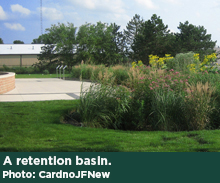 You can create and manage native plantings to provide ecosystem services in urban and suburban communities. These habitats include rain gardens, green roofs, community gardens, landscaping near homes, and less intensely used natural areas.
You can create and manage native plantings to provide ecosystem services in urban and suburban communities. These habitats include rain gardens, green roofs, community gardens, landscaping near homes, and less intensely used natural areas.
Urban
Rain gardens and retention basins
In cities, large areas of impermeable surfaces such as roads, sidewalks and rooftops, cover the permeable soil. 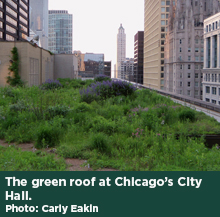 As a result, when it rains much of that water runs straight into waterways instead of soaking into the ground. Rain gardens are especially suitable where roofs collect large amounts of rain water. In these areas many native wetland plants can thrive. Native plants have also successfully been incorporated into city street plans as water retention basins associated with large, paved surfaces.
As a result, when it rains much of that water runs straight into waterways instead of soaking into the ground. Rain gardens are especially suitable where roofs collect large amounts of rain water. In these areas many native wetland plants can thrive. Native plants have also successfully been incorporated into city street plans as water retention basins associated with large, paved surfaces.
Green roofs
Green roofs contain plantings that decrease storm water runoff by soaking up the moisture that falls on the roof. Green roofs also insulate the roof, decreasing heating and cooling costs for the building and decreasing urban heat island effects. 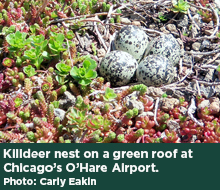 Depending on which plants are selected, green roofs can provide habitat for birds and support additional ecosystem services such as pollination.
Depending on which plants are selected, green roofs can provide habitat for birds and support additional ecosystem services such as pollination.
Community gardens
Shared, public gardening spaces are growing in popularity in urban areas, where they may replace empty lots. Native species could be incorporated around these community gardens to support beneficial insects to pollinate and control pests in gardens, as well as add beauty.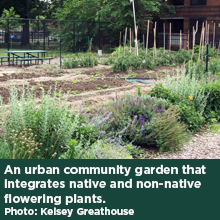
Suburban
Gardens
Home landscaping and flower gardens can be designed with native perennial, shrub and tree species. Native plants offer a large potential variety of plant sizes, flower colors and bloom periods and, once established, may need less watering and care than many non-native species. Adding native ground covers or expanding perennial flower borders can also reduce the proportion of your property that is turf and thereby reduce fuel use and CO2 emissions. 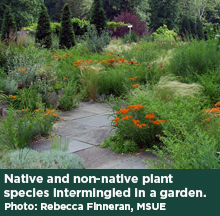 Visit the National Wildlife Federation’s website to create a certified wildlife habitat.
Visit the National Wildlife Federation’s website to create a certified wildlife habitat.
- Landscaping for birds
- Smart Gardening: MSU Extension's tips for using native plants along with a greener approach to lawns and soil.
In a garden setting consisting primarily of non-native plants, the transition to native plantings can be made gradually by replacing aging, diseased, or overgrown plants each season. This approach requires less commitment of both time and money initially, gives gardeners time to learn about native plant species options, and keeps mature plants in the garden. The resulting non-native and native species mixed together in garden settings can be just as attractive as the original non-native cultivated plants.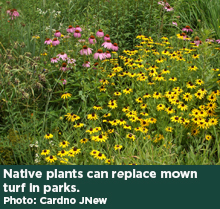
Parks and green spaces
In urban and suburban landscapes, there are many areas that could include native plants. “Naturalizing” portions of parks by replacing mown turf with native plants can reduce maintenance costs and increase wildlife habitat. Linking such areas together via a system of green spaces or wildlife corridors can further increase their benefits.



 Print
Print Email
Email